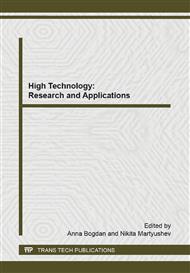p.272
p.278
p.282
p.286
p.292
p.297
p.303
p.309
p.314
Electrochemical Determination of Heparin in Pharmaceuticals with Using Malachite Green
Abstract:
In this paper for determination of heparin in pharmaceuticals by constant-current sweep voltammetry on the mercury-film electrode (MFE) we used cationic malachite green (MG) dye which is capable to form a complex with heparin. In the 0.05 M potassium tetraoxalate (KH3C4O8 ∙ 2H2O) buffer solution with pH 1.65 MG had a well-defined peak of electroreduction at -0.46 V (vs. CSE). During the study of electrochemical properties of heparin in complex with MG in cathodic potential range from 0.0 V to -1.3 V on MFE besides the signal from the dye at E = - 0.46 V the second signal at E = –0.87 V was found. Increasing the concentration of heparin in the solution led to decrease of signal intensity at E = -0.87 V. Optimum conditions for the electrochemical determination of heparin in dosage form with using MG were picked up. Influence of auxiliary components of heparin pharmacological solution on electroreduction of the complex MG-Hep was investigated. Under optimal conditions the decrease of reduction peak currents at E = -0.87 V was proportional to heparin concentration in the range from 3.9 ∙ 10-4 mg/ml to 3.9 ∙ 10-3 mg/ml.
Info:
Periodical:
Pages:
292-296
Citation:
Online since:
September 2014
Authors:
Keywords:
Price:
Сopyright:
© 2014 Trans Tech Publications Ltd. All Rights Reserved
Share:
Citation:


